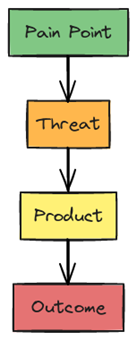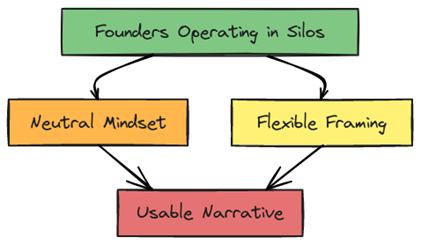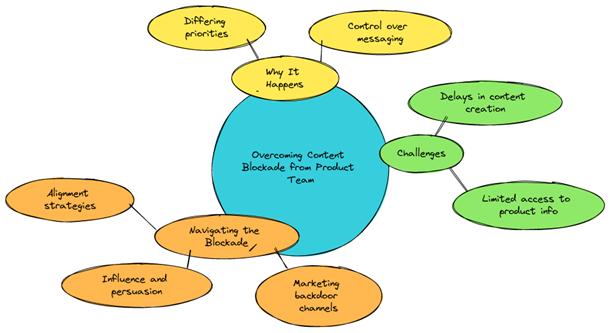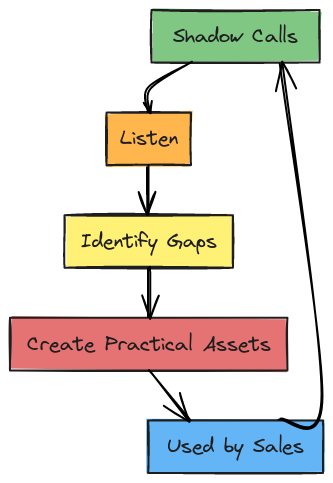How to Survive as a Content Marketer in a Cybersecurity Startup

Key takeaways
- Content marketers in cybersecurity startups face unique chaos—misaligned visions, vague product strategies, and constant change—requiring clarity, resilience, and proactive storytelling.
- Success often depends less on volume and more on strategic distribution, audience alignment, and business outcome-driven messaging.
- To thrive, marketers must create their own systems, build cross-functional trust, and adapt quickly to shifting dynamics in sales, product, and leadership.
High stakes, high burnout, and battle scars
Working in a cybersecurity startup can feel like assembling a plane mid-flight—with missing parts and passengers yelling conflicting directions.
For content marketers, this is especially challenging. You’re expected to drive revenue, build brand credibility, and align messaging—all while navigating chaotic org structures, shifting product strategies, and unforgiving timelines. The stakes are high, and the burn rate is often higher than the revenue.
I’ve been in the trenches of cybersecurity startups more times than I can count—and yes, I have the battle scars to prove it.
Here’s what I’ve learned along the way.
10 cybersecurity startup suvival strategies for content marketers
1: Earn credibility by translating abstract vision into value
Cybersecurity startups often present a mission that’s either overloaded with buzzwords—think “zero trust,” “next-gen AI protection”—or so narrow it’s commercially irrelevant. As a content marketer, you’re handed a narrative that’s either impossible to remember or too niche to scale.
Your job? Translate the abstract vision into something memorable, differentiated, and actionable—even if you have to do it without initial input from the C-suite.

2: Build narratives that can survive founder chaos
Founder dynamics in cybersecurity startups can be baffling. You may encounter internal silos, competing priorities, secretive behavior, or visionaries with grand plans that feel detached from reality.
This chaos often spills into marketing, making alignment tricky.
Your best move? Build a neutral, flexible narrative that loosely connects with all factions—until leadership alignment eventually emerges.

3: Design and launch your own product intel pipeline
When product treats marketing as an afterthought, you’ll often find out about new features just before—or even after—they launch. Add in a dose of overconfidence from product leaders and it’s a recipe for reactive chaos. The reality is that the product team is also getting pulled in multiple directions, sometimes even prioritizing feature requests from important customers rather than aligning to a broader roadmap.
Build your own feature pipeline using sprint reviews, engineer relationships, and direct customer feedback. Don’t wait to be told.

And often times you must accept the reality that you must market an immature cybersecurity product and work creatively with the limitations given to you.
4: Enable great sellers who aren’t cybersecurity experts
Even talented sellers often struggle with the complexity of cybersecurity products. Many won’t admit what they don’t know—and may see marketing as secondary.
Be proactive: create sales enablement content that makes them look sharp fast. Shadow calls, listen more than you talk, and fill knowledge gaps with practical assets they’ll actually use.

What makes a good sales call? Check out our blog, where I talk about the top five cybersecurity cold calls I still think about often. They shape how I think about outreach—and how to establish trust when seconds count.
5: Take baby steps to documenting workflows
The “we all wear many hats” mantra often masks a lack of process. Without documentation, tasks get duplicated—or completely dropped. When things go wrong, the blame game begins. This can easily be averted by implementing baby steps immediately.
Start small: create shared docs outlining roles, responsibilities, and ownership. Even a basic workflow prevents confusion and creates accountability.
Working hand in hand with sales to build a target account list is one of the most powerful trust building activities a cybersecurity marketer can deploy to establish more accountability.
6: Don’t hesitate to ask about the business model
You can’t create effective content if you don’t understand what the company actually sells—or how it makes money. Whether it’s SaaS, consulting, managed services, or a hybrid, lack of clarity here will derail your messaging.
Ask early and often: How do we make money? Who pays us, and why? Then, link your content directly to business outcomes like risk reduction, cost savings, or compliance.
7: Market the importance of content distribution
Publishing content is just step one. In cybersecurity, audiences won’t stumble across your blogs or whitepapers. Secure your distribution channels first—whether that’s newsletters, paid syndication, LinkedIn, or partnerships. One highly visible, well-distributed piece beats ten great ones collecting dust.
Content syndication is one of the most powerful marketing strategies AND tactics you can implement today. It cured me from content creations insomnia.
8: Don’t produce more content to validate your worth
Output doesn’t equal impact. Resist the urge to constantly create net-new content. Instead, repurpose and refresh what already exists.
Turn webinars into articles. Slice blog posts into social content. Update high-performing assets with fresh messaging or SEO insights. Be efficient, not frantic.
9: Embrace content critics, listen and learn
Cybersecurity audiences are diverse—from SMB owners to technical CISOs. Misjudge the technical level, and you’ll lose them immediately.
Talk to real customers. Join sales calls. Work closely with product marketing. When in doubt, segment your content to suit different personas—without dumbing it down or overcomplicating.
10: Mind analytics that will move the executive needle
Metrics matter—but not all metrics matter to your execs. Leadership often doesn’t care about CTRs or impressions.
Focus your analytics on business outcomes—pipeline impact, SQLs, brand lift. Know what your execs value and build reports that speak their language. Avoid hiding behind fuzzy KPIs. Define success early and iterate quickly.
Just ignore the drama, produce good content, and keep pushing for distribution
To survive—and thrive—as a marketer in a cybersecurity startup, you need grit, creativity, and a high tolerance for chaos. From decoding garbled visions to navigating founder dysfunction and building strategy in the dark, your ability to stay focused, flexible, and persistent will set you apart.
Create value. Fight for visibility. Drive impact. This space is chaotic—but it’s also one of the most dynamic, high-stakes, and meaningful sectors in tech.
❓ 5 Frequently Asked Questions (FAQs)
- What’s the biggest challenge for content marketers in cybersecurity startups?
Navigating ambiguity—especially when executive vision, product direction, and sales needs are misaligned or unclear. - How can I write content if I don’t understand the product or business model?
Start by asking foundational questions like “How do we make money?” and “Who are we selling to?”—then tie messaging to measurable business outcomes like risk reduction or compliance. - How do I deal with product teams that don’t communicate updates?
Don’t wait. Build relationships with engineers, attend sprint demos, and create a self-made product pipeline to stay ahead of releases. - What if the sales team doesn’t respect or collaborate with marketing?
Earn trust by producing content that helps them close deals faster—like cheat sheets, one-pagers, or tailored playbooks. Shadow calls to understand real needs. - How do I measure success if leadership doesn’t care about typical marketing metrics?
Align your KPIs with what leadership values—pipeline, SQLs, or brand visibility. Skip vanity metrics and define success based on strategic business contributions.
